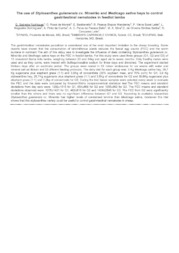The use of Stylosanthes guianensis cv. Mineirão and Medicago sativa hays to control gastrintestinal nematodes in feedlot lambs.
The use of Stylosanthes guianensis cv. Mineirão and Medicago sativa hays to control gastrintestinal nematodes in feedlot lambs.
Autoria: RODRIGUES, D. S.; MORAIS, O. R. de; BASTIANETTO, O.; WANDERLEY, R. P. B.; LEITE, P. V. B.; DOMINGUES, L. N.; CUNHA, A. P. da; BELLO, A. C. P. de P.; SILVA, M. X.; SALIBA, E. de O. S.; LEITE, R. C.
Resumo: The gastrintestinal nematodes parasitism is considered one of the most important limitation to the sheep breeding. Some reports have shown that the consumption of tanniniferous plants reduces the faecal egg counts (FEC) and the worm burdens in ruminant The aim of this stduy was to investigate the influence of diets containing Stylosanthes guianensis cv. Mineirão and Medicago sativa hays on the FEC in feedlot lambs. For this study were used three groups (G1, G2 and G3) of 13 crossbred Santa Inês lambs, weighing between 20 and 34kg and aged six to seven months. Only healthy males were used and as they come, were treated with Sulfaquinoxaline sodium for three days and drenched.
Ano de publicação: 2011
Tipo de publicação: Resumo em anais e proceedings
Unidade: Embrapa Caprinos e Ovinos
Palavras-chave: Dieta, Feno, Helminto Gastrintestinal, Medicago Sativa, Mineirão, Nematóide, Nematóides gastrintestinais, Ovino, Parasitismo, Raça Santa Inês, Stylosanthes Guianensis, Tanino
Observações
1 - Por padrão são exibidas publicações dos últimos 20 anos. Para encontrar publicações mais antigas, configure o filtro ano de publicação, colocando o ano a partir do qual você deseja encontrar publicações. O filtro está na coluna da esquerda na busca acima.
2 - Para ler algumas publicações da Embrapa (apenas as que estão em formato ePub), é necessário ter, no celular ou computador, um desses softwares gratuitos. Sistemas Android: Google Play Livros; IOS: iBooks; Windows e Linux: software Calibre.
Acesse outras publicações
Acesse a Base de Dados da Pesquisa Agropecuária (BDPA) para consultar o acervo completo das bibliotecas da Embrapa.

